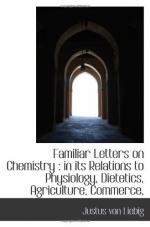LETTER IX
My dear Sir,
The facts detailed in my last letter will satisfy you as to the manner in which the increase of mass in an animal, that is, its growth, is accomplished; we have still to consider a most important question, namely, the function performed in the animal system by substances destitute of nitrogen; such as sugar, starch, gum, pectine, &c.
The most extensive class of animals, the graminivora, cannot live without these substances; their food must contain a certain amount of one or more of them, and if these compounds are not supplied, death quickly ensues.
This important inquiry extends also to the constituents of the food of carnivorous animals in the earliest periods of life; for this food also contains substances, which are not necessary for their support in the adult state. The nutrition of the young of carnivora is obviously accomplished by means similar to those by which the graminivora are nourished; their development is dependent on the supply of a fluid, which the body of the mother secretes in the shape of milk.
Milk contains only one nitrogenised constituent, known under the name of caseine; besides this, its chief ingredients are butter (fat), and sugar of milk. The blood of the young animal, its muscular fibre, cellular tissue, nervous matter, and bones, must have derived their origin from the nitrogenised constituent of milk—the caseine; for butter and sugar of milk contain no nitrogen.
Now, the analysis of caseine has led to the result, which, after the details I have given, can hardly excite your surprise, that this substance also is identical in composition with the chief constituents of blood, fibrine and albumen. Nay more—a comparison of its properties with those of vegetable caseine has shown—that these two substances are identical in all their properties; insomuch, that certain plants, such as peas, beans, and lentils, are capable of producing the same substance which is formed from the blood of the mother, and employed in yielding the blood of the young animal.
The young animal, therefore, receives in the form of caseine,—which is distinguished from fibrine and albumen by its great solubility, and by not coagulating when heated,—the chief constituent of the mother’s blood. To convert caseine into blood no foreign substance is required, and in the conversion of the mother’s blood into caseine, no elements of the constituents of the blood have been separated. When chemically examined, caseine is found to contain a much larger proportion of the earth of bones than blood does, and that in a very soluble form, capable of reaching every part of the body. Thus, even in the earliest period of its life, the development of the organs, in which vitality resides, is, in the carnivorous animal, dependent on the supply of a substance, identical in organic composition with the chief constituents of its blood.




